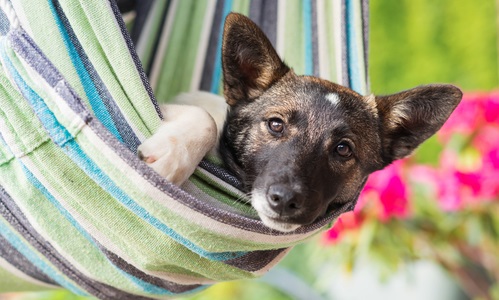When temperatures rise, humans flip on the air conditioning and reach for a cold drink to help them cool off. Dogs may not have these luxuries on demand, so loving pet parents try to help them out in other ways – such as haircuts and mesh dog beds, and plenty of water in their bowls. Ice cubes are another go-to method for treating canines on a hot summer day, but recent stories on the news and viral social media posts have made cautious pet parents wonder, “Is ice bad for dogs?”
It’s hard to imagine something so harmless causing injury or distress – after all, ice is routinely put in drinks and enjoyed with no ill effects. Does canine anatomy somehow render frozen water differently? The viral “dogs can’t have ice” warning bears a deeper dive on facts before a pet parent takes ice out of rotation as a dog treat.
Dogs, Ice, & Fear-Mongering
The various appearances of the dire warning about dogs and ice take several forms: social media posts are the most popular, followed by chain-style emails, SMS messaging, and finally, word of mouth. They tend to have several points in common:
- The warning is issued by “a vet” or someone that “works with animals,” but the name or facility is never mentioned, or a false one is given
- It specifically tells the story about a dog that was suffering from heat stroke or overheated, was given ice by his owner, which then caused him to experience a fatal “belly bloat” due to the change in his “core temperature”
- It warns owners not to give dogs any ice cubes to prevent the same thing happening to their own dogs and encourages them to share the message
Although this myth has been debunked multiple times by multiple groups, it persists because it appeals to dog owners’ innate sense of love and protection for their cherished canines. The mental narrative falls along the lines of, “well, it couldn’t hurt…” and the myth continues to travel around social groups and pet pages.
Is it Safe To Give Dogs Ice?
In a nutshell, dogs can safely have ice, and some vets even recommend ice in moderation. Ice helps encourage dogs that may be reluctant or unable to drink to stay hydrated, and it makes an excellent healthy treat, particularly in contrast to scraps of human food. The dog receives something that is enticing to chew, helps him stay hydrated, and doesn’t contain any harmful ingredients – not to mention ice is considerably less expensive than traditional dog treats!
As with any water given to a dog, ice should be made from clean, frozen water that is safe to drink – avoid fishing cubes out of a drink that may be harmful, such as an alcoholic cocktail, to offer a pup. Traces of the beverage may have frozen to the surface of the cube, making it unsafe for dogs.
Ice cubes can also be given directly to the dog or mixed in with water in his bowl to keep it cool – if he feels inclined to “bob for cubes” to crunch, he’ll be completely safe and healthy as he chomps away. This may also help make his water more enticing, and encourage him to drink more often, which may aid whole-body health, digestion, and even coat quality.

Pet Parent Pointer: For pet parents who have an ice maker on the fridge door (which typically includes both ‘ice cube’ or ‘crushed ice’ options), choosing the crushed ice chip option may be a safer bet, particularly for dogs who tend to wolf/gulp things down, puppies, or miniature breeds who may struggle with large cubes.
Some Ice & Dogs Don’t Mix
While the prevailing danger-upon-ingestion myth about dogs and ice is essentially false, that doesn’t mean that there aren’t some things that should be kept in mind. The larger and denser an ice cube is, the more of a threat it poses to a dog’s teeth. Dogs, like humans, get only two sets of teeth in their lifetime: their “puppy” or “milk” teeth, and their adult teeth.
Once the adult teeth grow in, any trauma or breakage to the teeth will be with the dog the rest of his life. If he crunches down on a cube the wrong way, he could potentially chip a tooth or break it off entirely. To avoid this, ice cubes should be kept small whenever possible, or floated in a water bowl to partially melt and soften.
And finally, just as with any dog treat, moderation is key. Giving a dog too many ice cubes habitually can cause issues, such as loss of appetite or tooth/mouth pain from the consistent cold. Give him ice cubes at the same frequency (or less) as organic biscuits for dogs or other edible treats and he’ll stay a happy, hydrated pup.
Ice Enrichment For Dogs
While many dogs love ice plain in regular cube form, a clever pet parent can make his ice treats even more engaging with some forethought and a freezer. Here are some pup-friendly icy treats worth considering this summer:
- The Big Kahuna: Take a large silicone cake mold or bowl and fill with water in stages, adding small edible treats and freeze-able toys, such as a large rubber ball, at each new layer. Once the bowl has frozen solid, de-mold it outside on the grass, where it can be licked and gnawed on during hot days outside.
- The Pupsicle: Fill a popsicle mold or small plastic cup with any mix of water, unsweetened/unsalted peanut butter, unsalted beef broth, mashed bananas, or blueberries. Use a thick pretzel rod or thin rawhide chews as the “sticks” and freeze solid. Offer the frozen treat outside in the yard to minimize mess as it melts.
- The Fill-Up: Using a Kong-style rubber toy with an internal cavity, fill the toy up with one of the food/liquid mixtures suggested for “pupsicles” as described above. Freeze the toy whole, placing in a cup if necessary to keep liquid contained as it freezes. This makes a great “crate treat” to chew and lick on during confined hours as an alternative to cbd dog treats, and may help distract separation anxiety-prone pups, too.
- The Ankle-Saver: When puppies’ milk teeth are ready to loosen and fall out, they go through a particularly trying period of teething: ankles, fingers, furniture, and shoes can all fall prey to their chomping little needle-teeth. They behave like this because the milk teeth are annoying or painful, and they’re naturally driven to gnaw to help remove them. Soak a dishrag in water and freeze it in a twisted shape before offering it to a puppy: he’ll be able to chew away happily as the icy saturation soothes his irritated gums and loosens his teeth.
Are Ice Baths Safe For Dogs?
Concern over feeding dogs ice cubes can sometimes translate to worry that ice isn’t safe for dogs at all. While it’s true that ice and snowy ground cover can hurt exposed paw pads if a dog is left outside too long, cold weather is fine in moderation for most breeds. The flip side of this temperature coin is ice baths to cool dogs down in hot weather – and that requires a little more caution.
In general, cold water is alright for a bath, provided that the dog leads the way. That means that if a pet parent, for example, leaves out a “kiddie pool” filled with cold water from the hose and some pieces of floating ice, the dog will decide if he wants to use it. If it’s too cold or uncomfortable, he simply won’t go in. If he becomes too cold in the water, he’ll get out.
If a dog looks overheated or in danger of heat stroke, it may seem logical to plunge them into an ice water bath to bring their temperature down quickly. In this case, ice water can be harmful as the dog is no longer leading the way. Manipulating his temperature so quickly can have negative health effects. For a dog in this scenario, vets will generally advise bringing him into a cooler place in the shade or indoors, and offering a gradual amount of cool water to drink instead.

Ice For Recovering Dogs
In many cases, a dog recovering from a health issue or surgery may be reluctant to eat and drink, or physically unable to get to their feeding area. Always discuss their nutritional needs with their veterinarian post-treatment, but proactively mention using ice for hydration. His vet may have a preference for the type of ice offered – e.g., chips or pellet ice versus large cubes – but they can offer advice on frequency and volume to help with hydration during recovery. In some cases, liquid medication may even be able to be “hidden” along with beef broth in cubes to ensure a reluctant canine medicine-taker gets everything he needs to thrive.
Summary: Dogs & Ice Safety
The true answer to “Is ice safe for dogs?” is yes – so long as it’s given sporadically and carefully. The “belly bloat” viral story about ice cubes and dogs is just that: a sensationalized account of a single experience that may or may not have happened. In reality, ice is an excellent medium for canine enrichment, hydration, and cooling off in the summer heat – so pet parents can tell their worries to “chill” and reach into the freezer the next time their
Sources Cited:
- “Is Ice Bad for Dogs?” PetMD.com, October 24, 2017, https://www.petmd.com/dog/general-health/ice-bad-dogs. Accessed July 26, 2020.
- Klein, Dr. Jerry, CVO. “Are Ice Cubes Good for Dogs?” American Kennel Club (AKC.org), April 24, 2017, https://www.akc.org/expert-advice/nutrition/are-ice-cubes-good-for-dogs/. Accessed July 26, 2020.
- Harris, David, BVSc MRCVS. “Can I put ice in my dog’s water bowl?” VetHelpDirect.com, July 31, 2018, https://vethelpdirect.com/vetblog/2018/07/31/can-put-ice-dogs-water-bowl/. Accessed July 26, 2020.
- Schlossnagle, Laurie. “Mental Stimulation Ideas For Dogs.” The Modern Dog Trainer.net, May 21, 2015, https://www.themoderndogtrainer.net/mental-stimulation-ideas-for-dogs/#:~:text=Ice%20sculptures%20%E2%80%93%20bowl%20or%20bucket,toys%20and%20treats%20out%20of.. Accessed July 26, 2020.




